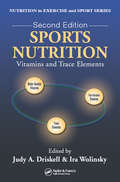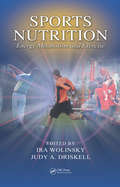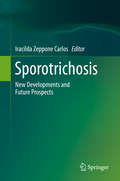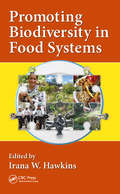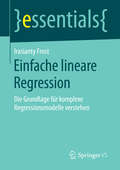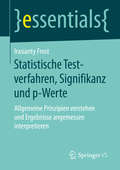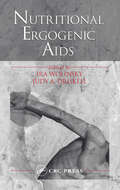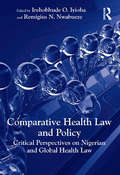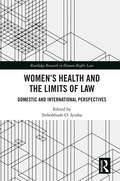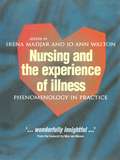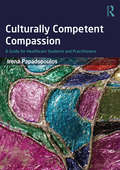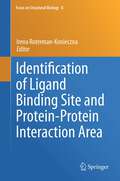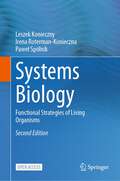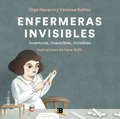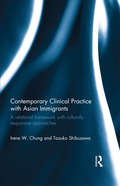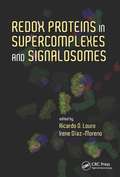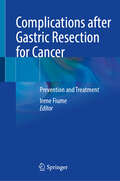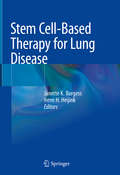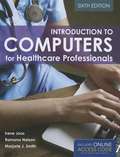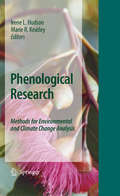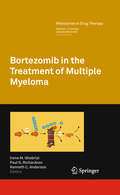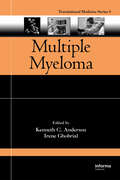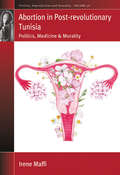- Table View
- List View
Sports Nutrition: Vitamins and Trace Elements, Second Edition
by Judy A. Driskell Ira WolinskyIn competitive sports where an extra breath or a millisecond quicker neural response can spell the difference between fame and mediocrity, a number of myths have persisted around the impact of what might be considered megadoses of various vitamins and trace elements. We do know that a growing body of research indicates that work capacity, oxygen co
Sports Nutrition: Energy Metabolism and Exercise (Nutrition in Exercise & Sport)
by Ira Wolinsky Judy A. DriskellExercise by itself tears down the body. To rebuild that body so that it expresses greater strength, endurance, and speed, requires sound nutritional practices based on fact rather than fad. Those practices must also recognize that specific needs vary greatly according to age, gender, and intensity of exercise.Sports Nutrition: Energy Metabo
Sporotrichosis
by Iracilda Zeppone CarlosThe book presents current affairs of Sporotrichosis as emergent disease with emphasis on the potential factors associated with genetic polymorphisms in Sporothrix complex. Constitutive and inducible factors play an essential role in the response of the fungal cell to the environment as determinant in the immunopathogenicity, highlighting clinical forms of Sporotrichosis and host immunocompetence. Also, a current issue interest in zoonotic transmission showing that a cat is the animal species most affected by Sporothrix species and their importance in the involvement in the human transmission. Readers can associate parameters of experimental immune response to disease development as well as the diagnostic, prophylaxis, and therapies that can be applied in the near future.
Promoting Biodiversity in Food Systems
by Irana W. HawkinsBiodiversity of the food system is crucial for food production and loss of biodiversity is a pressing issue. This book focuses on biodiversity’s crucial role in food systems, health and well-being, and fate of the natural environment. It provides practical recommendations on how proper food systems can sustain a healthier planet and protect biodiversity. Sections provide a comprehensive understanding of the urgent need for promoting biodiversity-promoting food systems that help maintain planetary boundaries that are at risk; mimic the natural processes of highly integrated ecosystems; and improve human/planetary health while providing a wholesome and sufficient food supply.
Einfache lineare Regression: Die Grundlage für komplexe Regressionsmodelle verstehen (essentials)
by Irasianty FrostDieses essential befasst sich mit der einfachen linearen Regression, der simpelsten Form von Regressionsmodellen, in der f#65533;r die Modellbildung nur eine einzige Einflussvariable ber#65533;cksichtigt wird. Leser finden in diesem Buch die Methode der kleinsten Quadrate zur Sch#65533;tzung der Modellparameter, Residualanalysen zur #65533;berpr#65533;fung der Modellannahmen sowie weitere statistische Verfahren zur Beurteilung des Modells. Zudem erfahren sie, wie das Modell als ein Prognoseinstrument eingesetzt werden kann. Somit erwerben Leser eine solide Grundlage zum Verst#65533;ndnis komplexer Regressionsans#65533;tze, bei denen mehrere Variablen die Zielgr#65533;#65533;e beeinflussen und nichtlineare Zusammenh#65533;nge vorliegen.
Statistische Testverfahren, Signifikanz und p-Werte: Allgemeine Prinzipien verstehen und Ergebnisse angemessen interpretieren (essentials)
by Irasianty FrostDieses essential erklärt das grundlegende Prinzip statistischer Testverfahren. Dabei stehen die Bedeutung der statistischen Signifikanz sowie des p-Wertes im Fokus. Häufig anzutreffende Fehlinterpretationen werden angesprochen. Dadurch wird ersichtlich, was ein signifikantes Ergebnis aussagt und, was es nicht aussagt. Der Leser wird somit befähigt, adäquat mit Testergebnissen umzugehen.
Nutritional Ergogenic Aids
by Irawolinsky Judy A DriskellNutritional Ergogenic Aids provides an up-to-date review of what is hypothetical and what is known about the most extensively used nutritional ergogenic aids; dietary supplements to enhance physical and athletic performance. Among the 23 aids discussed are branched-chain amino acids, carnitine, creatine, glucosamine, chrondroitin sulfate and taurine. An up-to-date review about what is hypothetical and what is known about the most extensively used ergogenic aids.
Comparative Health Law and Policy: Critical Perspectives on Nigerian and Global Health Law
by Irehobhude O. Iyioha Remigius N. NwabuezeHealth law and policy in Nigeria is an evolving and complex field of law, spanning a broad legal landscape and drawn from various sources. In addressing and interacting with these sources the volume advances research on health care law and policy in Nigeria and spells the beginning of what may now be formally termed the ’Nigerian health law and policy’ legal field. The collection provides a comparative analysis of relevant health policies and laws, such as reproductive and sexual health policy, organ donation and transplantation, abortion and assisted conception, with those in the United Kingdom, United States, Canada and South Africa. It critically examines the duties and rights of physicians, patients, health institutions and organizations, and government parastatals against the backdrop of increased awareness of rights among patient populations. The subjects, which are discussed from a legal, ethical and policy-reform perspective, critique current legislation and policies and make suggestions for reform. The volume presents a cohesive, comparative, and comprehensive analysis of the state of health law and policy in Nigeria with those in the US, Canada, South Africa, and the UK. As such, it provides a valuable comparison between Western and Non-Western countries.
Women's Health and the Limits of Law: Domestic and International Perspectives (Routledge Research in Human Rights Law)
by Irehobhude O. IyiohaDespite some significant advances in the creation and protection of rights affecting women’s health, these do not always translate into actual health benefits for women. This collection asks: 'What is an effective law and what influences law’s effectiveness or ineffectiveness? What dynamics, elements, and conditions come together to limit law’s capacity to achieve instrumental goals for women’s health and the advancement of women’s health rights?' The book presents an integrated, co-referential and sustained critical discussion of the normative and constitutive reasons for law’s limited effectiveness in the field of women’s health. It offers comprehensive and cohesive explanatory accounts of law’s limits and for the first time in the field, introduces a distinction between formal and substantive effectiveness of laws. Its approach is trans-systemic, multi-jurisdictional and comparative, with a focus on six countries in North America, Europe, Asia, and Africa and international human rights case law based on matters arising from Hungary, Portugal, Spain, Slovakia, the Czech Republic, Peru and Bolivia. The book will be a valuable resource for educators, students, lawyers, rights advocates and policymakers working in women’s health, socio-legal studies, human rights, feminist legal studies, and legal philosophy more broadly.
Nursing and The Experience of Illness: Phenomenology in Practice
by Irena Madjar Jo Ann WaltonNursing and the Experience of Illness encourages nurses to reflect on the experience of their patients, in order to improve their practice and to develop an individualised approach to care. Vivid case studies present real nursing encounters and offer a user-friendly model for independent research by the reader.This accessible introduction to phenomenology for nurses explains what has become one of the most widely used qualitative research methods within healthcare and covers topics including:*phenomenology in nursing*critical illness and intensive care*breast cancer and mastectomy*living with schizophrenia. Building on the work of key nursing theorist Patricia Benner, this readable way in to qualitative research in nursing will be suitable for both undergraduate and postgraduate nursing students.
Zwangsstörung und Zwangshandlungen: Eine Einführung für Pflege-, Gesundheits- und Sozialberufe
by Irena MikicMenschen mit Zwangsstörungen besser verstehen! Dieses Buch richtet sich an das interprofessionelle Therapieteam von Menschen mit Zwangsstörungen und hilft Betroffene besser zu verstehen und gezielter zu unterstützen. Durch konkrete Fallbeispiele und in leicht verständlicher Sprache bietet die Autorin eine Einführung in das komplexe Thema Zwangsstörung. Dabei liegt der Schwerpunkt nicht auf der Ursachenforschung der Erkrankung, sondern auf der Gefühlswelt der Betroffenen. Es geht darum den Blick für die Bedürfnisse zu schärfen und empathisch zu reagieren und zu helfen.
Culturally Competent Compassion: A Guide for Healthcare Students and Practitioners
by Irena PapadopoulosBringing together the crucially important topics of cultural competence and compassion for the first time, this book explores how to practise ‘culturally competent compassion’ in healthcare settings – that is, understanding the suffering of others and wanting to do something about it using culturally appropriate and acceptable caring interventions. This text first discusses the philosophical and religious roots of compassion before investigating notions of health, illness, culture and multicultural societies. Drawing this information together, it then introduces two invaluable frameworks for practice, one of cultural competence and one of culturally competent compassion, and applies them to care scenarios. Papadopoulos goes on to discuss: how nurses in different countries understand and provide compassion in practice; how students learn about compassion; how leaders can create and champion compassionate working environments; and how we can, and whether we should, measure compassion. Culturally Competent Compassion is essential reading for healthcare students and its combination of theoretical content and practice application provides a relevant and interesting learning experience. The innovative model for practice presented here will also be of interest to researchers exploring cultural competence and compassion in healthcare.
Identification of Ligand Binding Site and Protein-Protein Interaction Area
by Irena Roterman-KoniecznaThis volume presents a review of the latest numerical techniques used to identify ligand binding and protein complexation sites. It should be noted that there are many other theoretical studies devoted to predicting the activity of specific proteins and that useful protein data can be found in numerous databases. The aim of advanced computational techniques is to identify the active sites in specific proteins and moreover to suggest a generalized mechanism by which such protein-ligand (or protein-protein) interactions can be effected. Developing such tools is not an easy task - it requires extensive expertise in the area of molecular biology as well as a firm grasp of numerical modeling methods. Thus, it is often viewed as a prime candidate for interdisciplinary research.
Systems Biology: Functional Strategies of Living Organisms
by Irena Roterman-Konieczna Leszek Konieczny Paweł SpólnikThis open-access textbook is an excellent introduction to systems biology, which has developed rapidly in recent years. It discusses the processes in living organisms in an integrated way, enabling the reader to understand the fundamental principles and cause-effect relationships in biology and biochemistry. The authors have chosen an original but at the same time clear way of presenting the topics, repeatedly drawing comparisons and models from the macroscopic world and making the reader aware of the unity of the laws of physics, chemistry and biology. The fully updated 2nd edition also contains information that has only become available as a result of the increase in knowledge in recent years. This includes information on tumorigenesis, where significant progress has been made due to the explosive development of genetic knowledge as well as bioengineering with a highly effective technique adopted from the solutions of the bacterial world, such as CRISPR/CAS. This richly illustrated book is essential for postgraduate students and scientists of the following disciplines: biology, biotechnology, medicine, bioinformatics, robotics and automation, biocybernetics, and biomedical engineering. It is also an exciting read for anyone interested in biology.
Enfermeras invisibles
by Vanessa Ibáñez Olga Navarro Irene Bofill¿Quién fue la enfermera que salvó la vida de dos mil quinientos niños y niñas judíos del gueto de Varsovia? ¿Cuál es la historia de la mujer que inventó y patentó la jeringa que se puede utilizar con una sola mano? ¿O la que diseñó el portabebés y la mochila de oxígeno portátil? ¿Conoces la historia de la mujer que encabezó la primera campaña mundial de vacunación? Trepidantes aventuras de viajes y peligros, relatos de superación y grandes descubrimientos científicos es lo que vas a encontrar en la vida de estas catorce mujeres valientes e invisibles que dieron todo por los demás haciendo lo que mejor sabían, cuidar. Escrito por dos enfermeras después de una ardua investigación, este libro ilustrado es un homenaje a una profesión que merece ocupar un lugar predominante en la historia.
Contemporary Clinical Practice with Asian Immigrants: A Relational Framework with Culturally Responsive Approaches
by Tazuko Shibusawa Irene ChungMany first and second generation Asian immigrants experience acculturation challenges to varying extents. These challenges, such as language barriers, racial discrimination, underemployment, the loss of support networks and changes in family role and structure, may exacerbate a myriad of mental health issues. In addition, their help-seeking behaviour, as shaped by a general adherence to a collectivistic worldview and indirect communication style, often creates challenges for the practitioners who are trained under a Western practice modality. Drawing on literature from English-speaking countries with sizeable Asian immigrant populations such as the United States, Australia, New Zealand, Canada, and the United Kingdom, this text is designed especially for clinicians and students working with Asian immigrant populations. It discusses the therapeutic process in psychotherapy and counselling with these clients, exploring both key psychodynamic constructs and social systemic factors. Building on contemporary relational theory, which emphasizes the centrality of the helping relationship and sensitivity to the client’s subjective realities, the book demonstrates how western-based concepts and skills can be broadened and applied in an Asiacentric context, and can be therapeutic even in social service and case management service settings. There are chapters on issues such as domestic violence, intergenerational conflicts, depression amongst elders, and suicide, discussing the prevalence and nature of the mental health issues and each containing case vignettes from various Asian ethnic groups to illustrate the application of relational approaches. This book is an important cross-cultural reference for practising social workers and counsellors as well as for social work students undertaking clinical practice courses.
Redox Proteins in Supercomplexes and Signalosomes
by Ricardo O. Louro Irene Díaz-MorenoGet Insight on the Function of Supercomplexes in Biological SystemsRedox Proteins in Supercomplexes and Signalosomes is one of the first books to explore the key role played by redox proteins and their interaction network in a wide range of essential cellular processes in all domains of life. The book explains how the mitochondrial respiratory chai
Complications after Gastric Resection for Cancer: Prevention and Treatment
by Irene FiumeThis comprehensive guide serves as both an educational resource and a practical manual for surgeons performing gastric resections as well as clinicians involved in the care of gastric cancer patients. Given that gastric resections are major surgeries, the complications that arise postoperatively can be diverse and range in severity. By focusing on both common and rare complications and offering detailed management strategies, the book aims to improve patient outcomes and reduce mortality and morbidity associated with gastric resection for cancer.Each chapter is organized around specific complications, offering actionable advice on prevention and treatment. The guidance provided is based on the latest scientific literature, ensuring that healthcare providers have access to evidence-based approaches for effectively managing adverse events.
Stem Cell-Based Therapy for Lung Disease
by Janette K. Burgess Irene H. HeijinkThis book presents state-of-the-art pre-clinical models and clinical applications of stem-cell-based therapies applied to different lung diseases, with a special focus on the translation of bench data into clinical studies. Starting with the assumption that abnormal lung tissue repair and regeneration has emerged as the driving force underlying pathogenesis and progression in many lung diseases, it sheds new light on the potential of stem/stromal cells as drivers of repair and sources of reparative factors in the lung. The first part of the book offers an overview of stem cell types and mechanisms involved in lung development, homeostasis, repair and regeneration, and reveals the crucial role of the extracellular matrix within the lung microenvironment. In the second part, leading experts present the latest pre-clinical evidence and clinical applications of stem-cell-based therapies in a wide variety of lung diseases, ranging from COPD and lung fibrosis to other rare lung diseases. The last section discusses stem cell delivery systems and devices, such as aerosolised spray application. This book appeals to pneumologists, stem cell and matrix biologists, as well as bioengeneers with a special interest in regenerative medicine applied to pulmonary diseases.
Introduction To Computers For Healthcare Professionals
by Ramona Nelson Irene Joos Marjorie J. SmithThe only computer and information literacy book designed specifically for students in health care disciplines, Introduction to Computers for Healthcare Professionals, Fourth Edition explains hardware, popular software programs, operating systems, research applications, and computer-assisted communication, including sections on information access, evaluation and use, and the Internet. Built on the Computers in Small Bytes Foundation, the revised Fourth Edition continues to present this information with great detail and clarity, featuring the most recent MS Office programs, and focusing on the security of systems and data.
Emerging Electromagnetic Technologies for Brain Diseases Diagnostics, Monitoring and Therapy
by Lorenzo Crocco Irene Karanasiou Michael L James Raquel Cruz ConceiçãoThis timely book presents innovative technologies for use in the diagnosis, monitoring, and treatment of brain disease. These technologies offer exciting possibilities in the medical field owing to their low-cost, portability and safety. The authors address cerebrovascular diseases such as stroke, ischemia, haemorrhage, and vasospasm, these diseases having an ever-increasing societal relevance due to the global ageing population. The authors describe the potential of novel techniques such as microwave imaging and present innovative modalities for treatment of brain tumours using electromagnetic fields and nano-composites, as well as for monitoring brain temperature during surgery. Finally, Emerging Electromagnetic Technologies for Brain Diseases Diagnostics, Monitoring and Therapy addresses the perspectives which arise from multi-modal multi-spectral EM modalities, which make a synergic use of the different portions of the electromagnetic spectrum. This text will be of interest to readers from various different areas, given the fundamental interdisciplinarity of the subject matter. This includes researchers or practitioners in the field of electrical engineering, applied physicists, and applied mathematicians working on imaging applications for biomedical and electromagnetic technologies. Neurologists and radiologists may also find this book of interest, as may graduate students in these areas.
Phenological Research
by Irene L. Hudson Marie R. KeatleyAs climate change continues to dominate the international environmental agenda, phenology - the study of the timing of recurring biological events - has received increasing research attention, leading to an emerging consensus that phenology can be viewed as an 'early warning system' for climate change impact. A multidisciplinary science involving many branches of ecology, geography and remote sensing, phenology to date has lacked a coherent methodological text. This new synthesis, including contributions from many of the world's leading phenologists, therefore fills a critical gap in the current biological literature. Providing critiques of current methods, as well as detailing novel and emerging methodologies, the book, with its extensive suite of references, provides readers with an understanding of both the theoretical basis and the potential applications required to adopt and adapt new analytical and design methods. An invaluable source book for researchers and students in ecology and climate change science, the book also provides a useful reference for practitioners in a range of sectors, including human health, fisheries, forestry, agriculture and natural resource management.
Bortezomib in the Treatment of Multiple Myeloma (Milestones in Drug Therapy)
by Kenneth C. Anderson Irene M. Ghobrial Paul G. RichardsonMultiple Myeloma (MM) is the second most common type of blood cancer, resulting from an overproduction of cancerous infection-fighting white blood cells, known as plasma cells. Plasma cells are a crucial part of the immune system responsible for the production of antibodies. Bortezomib is a promising anticancer drug targeting the proteasome. This proteasome inhibitor induces cell stress and apoptosis in the cancer cells. While multiple mechanisms are likely to be involved, proteasome inhibition may prevent the degradation of pro-apoptotic factors, permitting activation of programmed cell death in neoplastic cells dependent upon the suppression of proapoptotic pathways. This monograph on bortezomib is a valuable source of information for researchers and clinicians from the fields of oncology and pharmacology, working either in academia or the pharmaceutical industry.
Multiple Myeloma: Translational and Emerging Therapies (Translational Medicine)
by Kenneth C. Anderson Irene M. GhobrialMultiple myeloma is the second most prevalent hematological malignancy, with over 55,000 new cases diagnosed each year. This exciting new text, edited by lauded authorities on the topic, stands as the only available reference to assemble, review, and synthesizes the latest studies on translational therapies and clearly explains the impact of molecular pathogenesis, biology, and prognostic factors on the diagnosis, prognosis, and individualization of treatment and the development of novel therapeutic options for patients with myeloma.
Abortion in Post-revolutionary Tunisia: Politics, Medicine and Morality (Fertility, Reproduction and Sexuality: Social and Cultural Perspectives #46)
by Irene MaffiAfter the revolution of 2011, the electoral victory of the Islamist party ‘Ennahdha’ allowed previously silenced religious and conservative ideas about women’s right to abortion to be expressed. This also allowed healthcare providers in the public sector to refuse abortion and contraceptive care. This book explores the changes and continuity in the local discourses and practices related to the body, sexuality, reproduction and gender relationships. It also investigates how the bureaucratic apparatus of government healthcare facilities affects the complex moral world of clinicians and patients.
